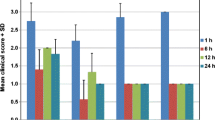Abstract
Purpose
To evaluate the efficacy of topical dexamethasone and topical FK506 treatment on allergic inflammation in conjunctiva, we performed a comparative study using a mouse experimental allergic conjunctivitis model.
Methods
The experimental allergic conjunctivitis model was developed by ovalbumin (OVA) instillation after OVA sensitization by intraperitoneal application of a mixed solution of OVA and aluminum hydroxide. The Balb/c mice of the experimental allergic conjunctivitis model were divided into three groups, depending on whether or not they received topical treatment and which type of treatment they received. The allergy group comprised six mice without topical treatment; the dexamethasone (Dx) group comprised six mice receiving topical 0.1% dexamethasone ointment treatment; and the FK506 (FK) group comprised six mice receiving topical 0.1% FK506 ointment treatment. The negative control group comprised six mice with neither sensitization nor topical treatment. For the histological examination, frozen sections of the eyelids, eyeballs, and lacrimal glands were stained with acid Giemsa stain or, in the immunohistochemical method, with alkaline phosphatase–antialkaline phosphatase (APAAP), for CD4. Densities of eosinophils and CD4-positive lymphocytes in the conjunctival tissue were counted. Productive C ε gene expression in the conjunctival tissue, including the lacrimal gland, was also evaluated by reverse transcriptase polymerase chain reaction (RT-PCR).
Results
In the histological study, the cell density of eosinophils infiltrating into subconjunctival tissues was 66.3 ± 34.7 cells/mm2 (mean ± SD) for the allergy group, 2.5 ± 4.2 cells/mm2 for the Dx group, 4.2 ± 8.6 cells/mm2 for the FK group, and 3.7 ± 7.6 cells/mm2 for the negative control group. The cell density of CD4-positive cells infiltrating into subconjuctival tissues was 145.9 ± 66.4 cells/mm2 for the allergy group, 10.0 ± 12.9 cells/mm2 for the Dx group, 10.1 ± 15.5 cells/mm2 for the FK group, and 21.7 ± 17.8 cells/mm2 for the negative control group. The allergy group showed significant differences in the density of eosinophils and CD4-positive cells compared with those of the Dx (P < 0.0001) and FK (P < 0.0001) groups. In the RT-PCR study, the expression of productive C ε gene was positive in the Dx group, but negative in the allergy group, the FK group, and the negative control group.
Conclusions
Topical Dx and FK506 treatments were both efficacious in suppressing eosinophil and lymphocyte infiltration into subconjunctival tissue in the mouse experimental allergic conjunctivitis model. However, the influence of their IgE productive mechanisms seemed to differ, causing different efficacy of productive C ε gene expression in the conjunctival tissue. Jpn J Ophthalmol 2005;49:205–210© Japanese Ophthalmological Society 2005
Similar content being viewed by others
Author information
Authors and Affiliations
Corresponding author
About this article
Cite this article
Shoji, J., Sakimoto, T., Muromoto, K. et al. Comparison of Topical Dexamethasone and Topical FK506 Treatment for the Experimental Allergic Conjunctivitis Model in Balb/c Mice. Jpn J Ophthalmol 49, 205–210 (2005). https://doi.org/10.1007/s10384-004-0187-3
Received:
Accepted:
Issue Date:
DOI: https://doi.org/10.1007/s10384-004-0187-3




